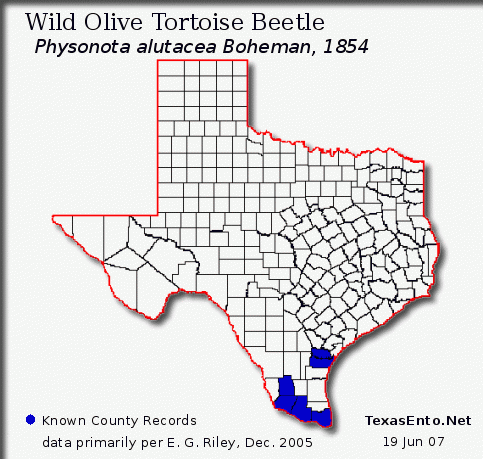|
|
|
Return to Texas Entomology - Compiled by Mike Quinn
|
|
|
(communal feeding larvae (left) and adult beetle (not shown to the same scale))
NABA Butterfly Park, Mission, Hidalgo Co., Texas
|
Sabal Palm Grove, Brownsville,
|

|
County Record Data from E.G. Riley, Dec. 2005
Range: Columbia north to south Texas.
Hosts:
In Texas: Cordia boissieri (Boraginaceae)
Common Names: Wild Olive, Mexican Olive, Anacahuita
Photos: Whole Tree, Flwr & Lvs - TAMU
County Range Map: USDA Plants DatabaseOther host plants south of Texas:
Cordia dentata - Mexico south to northern South America
Cordia inermis - Western Mexico down through Central America
Cordia macrostachya - restricted to Panama
Similar Species:
About 40 species comprise this genus which occurs from northern South America to southern Canada, with its greatest species diversity centered in Mexico. (The genus needs revision.) Five species occur in the United States, but only Physonota alutacea occurs in Texas.
Physonota arizonae, occurs in Arizona and hosts on members of the aster family, Asteraceae.
Physonota helianthi, occurs in the the northeastern U.S. and hosts on members of the aster family, Asteraceae.
Physonota unipunctata, occurs widely across eastern U.S. and hosts on members of the mint family, Lamiaceae.
Physonota calochroma floridensis, found in south Florida and hosts on Cordia sebestena, Boraginaceae family
Physonota pacifica was described from "California" but is only known to occur in Baja California and Sonora.Physonota attenuata, occurs as far north as Tamaulipas, Mexico and hosts on Cordia dentata and C. seleriana
Physonota ovalis, occurs as far north as Nuevo Leon, Mexico. Host unknown.
Note:
Biological Control of Weeds in Mauritius*
In addition to Opuntia, the other fully successful weed biocontrol program in Mauritius targeted the woody shrub, black sage (Cordia curassavica) which, by the 1930s, was covering large tracts of the island in dense scrub. The first agent introduced from the native range of the target weed in the Caribbean was a chrysomelid beetle, Physonota alutacea, in 1947. Despite over 30,000 individuals being released as adults, larvae, or eggs, the insect failed to establish, possibly because of interference from ants (Williams 1950, Fowler et al. 2000)
*Mauritius is a small (60 x 45 km) tropical island country in the Indian Ocean, 880 km east of Madagascar. Mauritius has been an active centre for biological control.
Photos: BugGuide.Net
Etymology:
Physonota alutacea Boheman
physo (G). Bellows; a bladder, air sac, bubble
=notum (G). The back
alut, =a (L). Leather
Biography: Carl Henrik Boheman (1796 - 1868) was a Swedish entomologist. - Wikipedia
References:
Arnett, R.H., Jr., M.C. Thomas, P. E. Skelley & J.H. Frank. (editors). 2002. American Beetles, Volume II: Polyphaga: Scarabaeoidea through Curculionoidea. CRC Press. 861 pp.
Barber, H.S., 1916. A review of North American tortoise beetles (Chrysomelidae; Cassidinae.). Proc. Ent. Soc. Wash., 18: 113-127.
Blackwelder, R.E., 1944-1957. Checklist of the Coleopterous insects of Mexico, Central America, the West Indies, and South America, part 4. Smithsonian Institution US Natural History Museum Bulletin 185, Parts 1-6. 1492 pp.
Boheman, C.H., 1854. Monographia Cassididarum. Tomus secundus. Holmiae, 506 pp.
Borror, D.J. 1960. Dictionary of Word Roots and Combining Forms. National Press Books, Palo Alto. v + 134 pp.
Clark, S.M., D.G. LeDoux, T.N. Seeno, E.G. Riley, A.J. Gilbert and J.M. Sullivan. 2004. Host plants of leaf beetle species occurring in the United States and Canada (Coleoptera: Megalopodidae, Orsodacnidae, Chrysomelidae exclusive of Bruchinae). Coleopterists Society, Special Publication no. 2, 476 pp.
Fowler, S.V., S. Ganeshan, J. Mauremootoo, & Y. Mungroo. 2000. Biological Control of Weeds in Mauritius: Past Successes Revisited and Present Challenges. Pp. 43-50 in: Neal R. Spencer (editor). Proceedings of the X International Symposium on Biological Control of Weeds 4-14 July 1999, Montana State University, Bozeman.
Olmstead, K.L., & Denno, R.F. 1992. Cost of shield defense for tortoise beetles (Coleoptera: Chrysomelidae). Environmental Entomology 17: 237-243.
Olmstead, K.L., & Denno, R.F. 1993. Effectiveness of tortoise beetle larval shields against different predator species. Ecology 74: 1394 1405.
Peterson, A. 1951. Larvae of Insects: An introduction to Nearctic species. Part II. Coleoptera, Diptera, Neuroptera, Siphonaptera, Mecoptera, Trichoptera. Edwards Bros., Inc., Ann Arbor, Mich. 416 p.
Riley, E. G., S.M. Clark, & T.N. Seeno. 2003. Catalog of the leaf beetles of America north of Mexico (Coleoptera: Megalopodidae, Orsodacnidae and Chrysomelidae, excluding Bruchinae). Coleopterists Society, Special Publication no. 1, 290 pp.
Riley, E.G. & W.R. Enns. 1979. An annotated checklist of Missouri leaf beetles (Coleoptera: Chrysomelidae). Trans. Missouri Acad. Scien., Biol. Scien., 13: 53-83.
Sanderson, M.W. 1948. Larval, pupal, and adult stages of North American Physonota (Chrysomelidae). Ann. Entomol. Soc. Amer., 41: 468-477.
Wilcox, J.A., 1975. Chrysomelidae. in: R.H. Arnett Jr., Checklist of the beetles of North and Central America and the West Indies. North American Beetle Fauna Series. Flora & Fauna Publications, Gainesville, 166 pp.
Williams, J.R. 1950. The introduction of Physonota alutacea Boheman (Col., Cassid.) into Mauritius. Bull. Entomol. Res. 40: 479–480.
Woodruff, R.E. 1976. The tortoise beetles of Florida III, Eurypepla calochroma floridensis Blake (Coleoptera: Chrysomelidae). Fla. Dept. Agr. Consumer Serv., Entomol. Circ. 163: 1-2.
19 Oct 2009 © Mike Quinn / entomike@gmail.com / Texas Entomology / Texas Beetle Information